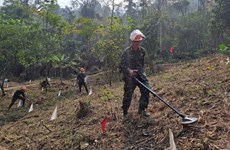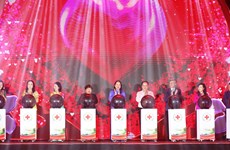Technology helps reduce nation's infertility rate
Vietnamese and foreign experts in assisted reproductive technology
(ART) discussed advancements and practical experiences in infertility
diagnosis and treatment at the second national infertility conference
held in HCM City on Aug. 6.
Vietnamese and foreign experts in assisted reproductive technology
(ART) discussed advancements and practical experiences in infertility
diagnosis and treatment at the second national infertility conference
held in HCM City on Aug. 6.
"Vietnam has made significant strides in infertility treatment in the last 14 years" since the country's first Assisted Reproductive Technology centre was set up at [the HCM City-based] Tu Du Hospital in 1997, Deputy Minister of Health Dr Nguyen Viet Tien said.
Diagnosis and treatment of infertility had not developed in Vietnam before 1997.
All 14 ART centres in the country now adopted advanced technologies that helped increase the success rate of in-vitro fertilisation, including assisted hatching, in-vitro maturation and intracytoplasmic sperm injection.
A draft national population and reproductive health programme for 2011-20 targeted reducing infertility by 50 percent.
Some 10-15 percent of the child-bearing population was infertile. The sterility rate was 40 per cent each for husbands and wives while in 10 percent of the cases, both were.
Globally, the infertility rate was 14 to 20 percent.
Hoang Thi Diem Tuyet, deputy director of Tu Du Hospital, said the IVF success rate in Vietnam was 30-44 percent, the same as the global rate.
So far more than 10,000 IVF babies had been born in the country, including nearly 4,100 at Tu Du Hospital, she said.
She called on the Ministry of Health to use information technology to improve management of data at ART centres, including that of egg and sperm donations.
They were now being managed individually by various centres, she said. Since they did not share information, there was a high risk of children born from the eggs or sperms of the same donor marrying each other, she warned./.
"Vietnam has made significant strides in infertility treatment in the last 14 years" since the country's first Assisted Reproductive Technology centre was set up at [the HCM City-based] Tu Du Hospital in 1997, Deputy Minister of Health Dr Nguyen Viet Tien said.
Diagnosis and treatment of infertility had not developed in Vietnam before 1997.
All 14 ART centres in the country now adopted advanced technologies that helped increase the success rate of in-vitro fertilisation, including assisted hatching, in-vitro maturation and intracytoplasmic sperm injection.
A draft national population and reproductive health programme for 2011-20 targeted reducing infertility by 50 percent.
Some 10-15 percent of the child-bearing population was infertile. The sterility rate was 40 per cent each for husbands and wives while in 10 percent of the cases, both were.
Globally, the infertility rate was 14 to 20 percent.
Hoang Thi Diem Tuyet, deputy director of Tu Du Hospital, said the IVF success rate in Vietnam was 30-44 percent, the same as the global rate.
So far more than 10,000 IVF babies had been born in the country, including nearly 4,100 at Tu Du Hospital, she said.
She called on the Ministry of Health to use information technology to improve management of data at ART centres, including that of egg and sperm donations.
They were now being managed individually by various centres, she said. Since they did not share information, there was a high risk of children born from the eggs or sperms of the same donor marrying each other, she warned./.












